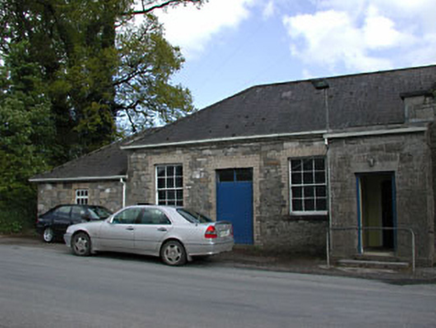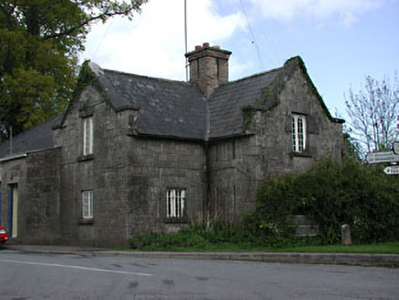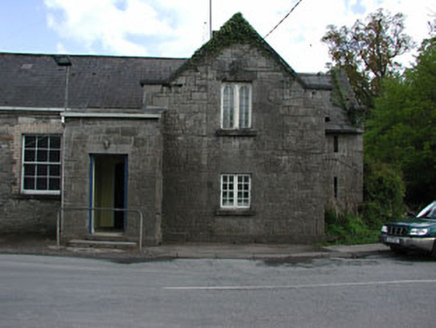Survey Data
Reg No
14403706
Rating
Regional
Categories of Special Interest
Scientific
Original Use
Garda station/constabulary barracks
Historical Use
House
Date
1849 - 1889
Coordinates
291492, 255537
Date Recorded
15/05/2002
Date Updated
--/--/--
Description
Detached three-bay single-storey constabulary barrack with half-dormer attic, c.1870, on a T-shaped plan centred on single-bay full-height gabled projecting breakfront. Occupied, 1901. Vacated, 1906. Now disused. Pitched slate roof on a T-shaped plan centred on pitched (gabled) slate roof (breakfront), lichen-covered ridge tiles, red brick Running bond central chimney stack on chamfered plinth having corbelled stepped stringcourse below capping supporting terracotta or yellow terracotta pots, cut-limestone coping to gables on kneelers, and cast-iron rainwater goods on exposed timber rafters retaining cast-iron octagonal or ogee hoppers and downpipes. Part repointed snecked limestone walls on benchmark-inscribed cut-limestone plinth with cut-limestone flush quoins to corners. Square-headed central window opening in tripartite arrangement with cut-limestone block-and-start surround framing timber casement windows having square glazing bars. Square-headed window opening in bipartite arrangement (half-dormer attic) with cut-limestone block-and-start surround framing timber casement windows having square glazing bars. Paired square-headed "loops" with cut-limestone surrounds. Square-headed window openings in bipartite arrangement (ground floor) with cut-limestone sills, and cut-limestone lintels framing timber casement windows behind cast-iron bars. Square-headed window openings in bipartite arrangement (half-dormer attic) with cut-limestone block-and-start surrounds framing timber casement windows having square glazing bars. Road fronted on a corner site.
Appraisal
A constabulary barrack erected by Edward Plunkett (1808-89), sixteenth Baron of Dunsany, representing an integral component of the nineteenth-century built heritage of County Meath with the architectural value of the composition confirmed by such attributes as the compact plan form centred on an expressed breakfront; the construction in a deep grey limestone demonstrating good quality workmanship; the diminishing in scale of the openings on each floor producing a graduated tiered visual effect; the neo-medieval "loops"; and the high pitched roof. A prolonged period of neglect notwithstanding, the form and massing survive intact together with substantial quantities of the original fabric, both to the exterior and to the interior, thus upholding the character or integrity of a constabulary barrack forming part of a self-contained ensemble (including 14403704 - 14403705) making a pleasing visual statement in a sylvan street scene. NOTE: Occupied (1901) by James Kavanagh (----), 'Sergeant [in] Royal Irish Constabulary' (NA 1901); and last occupied by the novelist Lilian Roberts Finlay (1915-2011).





